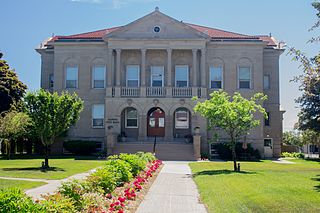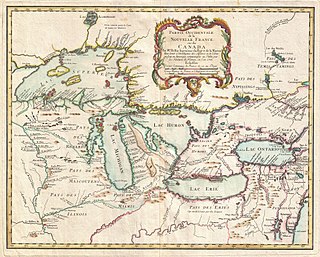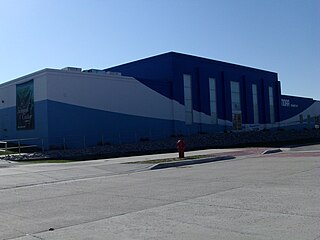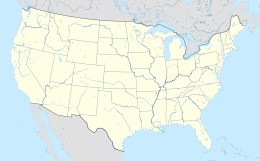
Lake Huron is one of the five Great Lakes of North America. It is shared on the north and east by the Canadian province of Ontario and on the south and west by the U.S. state of Michigan. The name of the lake is derived from early French explorers who named it for the indigenous people they knew as Huron (Wyandot) inhabiting the region. Hydrologically, Lake Huron comprises the eastern portion of Lake Michigan–Huron, having the same surface elevation as Lake Michigan, to which it is connected by the 5-mile-wide (8.0 km), 20-fathom-deep Straits of Mackinac. Combined, Lake Michigan–Huron is the largest freshwater lake by area in the world. The Huronian glaciation was named from evidence collected from Lake Huron region. The northern parts of the lake include the North Channel and Georgian Bay. Saginaw Bay is located in the southwest corner of the lake. The main inlet is the St. Marys River from Lake Superior, and the main outlet is through the St. Clair River toward Lake Erie. Lake Huron has a fairly large drainage basin covering parts of Michigan and Ontario. Water flows through Lake Huron faster than the other Great Lakes with a retention time of only 22 years.

Presque Isle County is a county in the Lower Peninsula of the U.S. state of Michigan. As of the 2020 census, the population was 12,982. The county seat is Rogers City. The county was authorized by state legislative action on April 1, 1840, but the county government was not established until 1871. The government was reorganized in 1875.

Alpena County is a county in the U.S. state of Michigan. As of the 2020 census, the population was 28,907. The county seat is Alpena. It is considered to be part of Northern Michigan.

Alpena is a city in the U.S. state of Michigan. It is the county seat of Alpena County, and is the only city within the county. The population was 10,197 at the 2020 census, making it the third most populated city in the Northern Michigan region, after Traverse City and Cadillac. The city is surrounded by Alpena Township, but the two are administered autonomously. It is the core city of the Alpena micropolitan statistical area, which encompasses all of Alpena County and had a total population of 28,907 at the 2020 census.

Alpena Township, officially the Charter Township of Alpena, is a charter township of Alpena County in the U.S. state of Michigan. As of the 2020 census, the township population was 9,116. The city of Alpena is surrounded by the township, but the two are administered autonomously. Alpena Township is the fourth-largest township by population in Northern Michigan, and the largest outside Grand Traverse County.

Thunder Bay is a bay in the U.S. state of Michigan on Lake Huron. The bay extends from North Point at 45°01′19″N83°15′58″W to South Point at 44°53′00″N83°18′51″W.

Thunder Bay National Marine Sanctuary and Underwater Preserve is a United States National Marine Sanctuary on Lake Huron's Thunder Bay, within the northeastern region of the U.S. state of Michigan. It protects an estimated 116 historically significant shipwrecks ranging from nineteenth-century wooden side-wheelers to twentieth-century steel-hulled steamers. There are a great many wrecks in the sanctuary, and their preservation and protection is a concern for national policymakers. The landward boundary of the sanctuary extends from the western boundary of Presque Isle County to the southern boundary of Alcona County. The sanctuary extends east from the lakeshore to the international border. Alpena is the largest city in the area.
Gull Island is the name of a dozen small islands in the U.S. state of Michigan.

The Thunder Bay River is a 75.4-mile-long (121.3 km) river in the U.S. state of Michigan. It drains much of Alpena County and Montmorency County, and a small portion of Oscoda County, into Thunder Bay, a bay of Lake Huron, on the eastern side of northern Michigan. The mouth of the river is in the heart of downtown Alpena and is guarded by the Alpena Light Station.
Thunder Bay Island is a 215-acre (87 ha) island in Lake Huron. The island is one of eight constituent islands of the Michigan Islands National Wildlife Refuge. The island is part of Alpena Township in Alpena County. It marks the entrance to Thunder Bay, the harbor of Alpena, Michigan and the location of the Thunder Bay National Marine Sanctuary.

The Alpena Light, also known as the Thunder Bay River Lighthouse or Alpena Breakwater Light, is a lighthouse on Lake Huron near Alpena, Michigan. Standing on the north breakwater of Alpena Harbor, the light marks the entrance to the Thunder Bay River from Thunder Bay. The current lighthouse, built in 1914, replaced earlier wooden structures which had been in use since 1877 and 1888. The current light is a weather-protected structure on a steel frame. It was added to the National Register of Historic Places in 2006, and the state inventory list the same year.

The Sturgeon Point Light Station is a lighthouse on Lake Huron in Haynes Township, Alcona County, northeastern lower Michigan. Established to ward mariners off a reef that extends 1.5 miles (2.4 km) lakeward from Sturgeon Point, it is today regarded as a historic example of a Cape Cod style Great Lakes lighthouse.
Michigan Islands Wilderness Area, a relatively small wilderness area of 12.5 acres (0.05 km2.), consists of Pismire Island, Scarecrow Island, and Shoe Island within the Michigan Islands National Wildlife Refuge. These three islands, which constitute part of the group of islands that make up the larger refuge, were elevated to the rank of a United States wilderness area in 1970. All three islands are noted for their infrequent human visitation and their roles as breeding grounds for freshwater wading birds, such as the great blue heron.

Thunder Bay Island Light, located on Thunder Bay Island's southeast tip, is one of the oldest operating lighthouses in Michigan. The third operating U.S. lighthouse in Lake Huron was built here in 1831, but it disintegrated almost at once and was rebuilt in 1832 of local limestone. This 40-foot (12 m) 1830s light tower was raised 10 feet (3.0 m)) to a height of 50 feet (15 m) in 1857, and sheathed with brick. A fourth order Fresnel lens was installed. This 1857 light tower is the current Thunder Bay Island Light, although the tower has been further altered and is currently 63 feet (19 m) high.

Rockport State Recreation Area is a 4,237-acre (17.15 km2) state park located along the shore of Lake Huron in Alpena and Presque Isle counties in the state of Michigan. It is operated by the Michigan Department of Natural Resources and was established in 2012. The park contains limestone formations and an old limestone quarry. There is a deep water boat launch that can accommodate all sizes of watercraft. The park is located along the Lake Huron Flyway and is used to gauge the health of Lake Huron and its shoreline environment. Several ship wrecks can be found off-shore in the Thunder Bay National Marine Sanctuary including the Portland and the Portsmouth. The park was previously known as "The Rockport property" and is not far north of Alpena, Michigan.
The Besser Museum for Northeast Michigan is a community museum serving Alpena County and surrounding counties in the U.S. state of Michigan. Alpena is a port city on Lake Huron. The museum defines its role broadly — to preserve, protect and present history and culture closely connected with the heritage of Northern Michigan and the Great Lakes. The museum includes a small publicly-owned planetarium.

SS Choctaw was a steel-hulled American freighter in service between 1892 and 1915, on the Great Lakes of North America. She was a so-called monitor vessel, containing elements of traditional lake freighters and the whaleback ships designed by Alexander McDougall. Choctaw was built in 1892 by the Cleveland Shipbuilding Company in Cleveland, Ohio, and was originally owned by the Lake Superior Iron Company. She was sold to the Cleveland-Cliffs Iron Company in 1894 and spent the rest of her working life with it. On her regular route between Detroit, Escanaba, Marquette, and Cleveland, she carried iron ore downbound, and coal upbound.

SS Russia was an iron-hulled American Great Lakes package freighter that sank in a Lake Huron gale on April 30, 1909, near DeTour Village, Michigan, with all 22 of her crew and one passenger surviving.
















